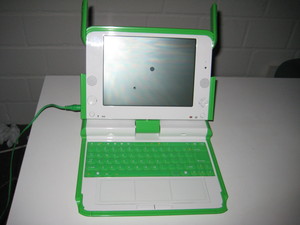Wednesday, July 2. 2008
Routable OSM maps on Garmin with MapSource / WINE
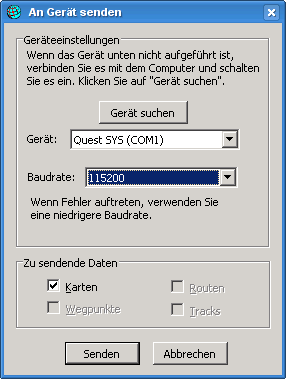 There are two tools out there for Linux to put Garmin maps (which you can convert from OpenStreetMap Data) on devices, sendmap (proprietary) and qlandkarte (free). Sadly, both don't support my device (Garmin Quest), so I had to find an alternative solution. This should also work with other garmin devices.
There are two tools out there for Linux to put Garmin maps (which you can convert from OpenStreetMap Data) on devices, sendmap (proprietary) and qlandkarte (free). Sadly, both don't support my device (Garmin Quest), so I had to find an alternative solution. This should also work with other garmin devices.After some playing around, I managed to get it running with MapSource on wine. I've used wine 1.1.0 on Gentoo, if you have problems, be sure to get a recent wine version.
Steps to do:
- Download MapSource_6137.exe from the Garmin webpage.
- Use 7-Zip to unpack the exe to some directory: 7z x MapSource_6137.exe
- Install MAIN.msi: wine start MAIN.msi
- Install MapSource: wine Setup.exe
- Get one of the MapSource Installers from here and install it: wine Setup_OSM-Germany-2008-06-11.exe
- wine doesn't support usb, so you need the garmin_gps module. If it's installed on your system, it should load automatically after attaching your device and switching it on.
- You should now have a device ttyUSB0, which you need to symlink as com1 for wine: ln -s /dev/ttyUSB0 ~/.wine/dosdevices/com1
- Run MapSource: wine ~/.wine/drive_c/MapSource/MapSource.exe
- Go to Settings -> Transfer, there you can select a serial port. Select COM1.
- Click the map selection tool from the buttons and select an area.
- Select Transfer -> Transfer to device. If everything went fine, it'll detect your garmin device attached to the serial port and you can start your upload.
Tuesday, June 17. 2008
Linux on a Wii
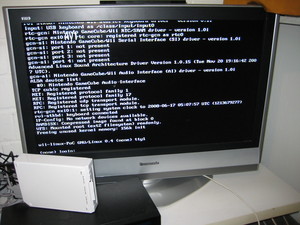 Today I played around a bit with the stuff done by the Wii homebrew/hacking community, which is far more advanced than I had expected.
Today I played around a bit with the stuff done by the Wii homebrew/hacking community, which is far more advanced than I had expected.I had the game Twilight Princess borrowed by a friend. For those who don't know, using this game you can run homebrew software on the Wii without the need of a modchip.
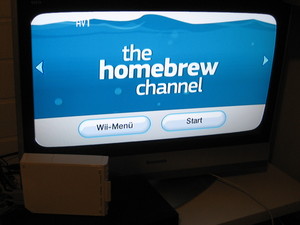 The way this works is that first you install a modified savegame for Twilight Princess, afterwards you can install the Homebrew Channel. The Homebrew Channel will stay in the main Wii Menu and you'll be able to run various stuff from there. While looking around the various webpages covering the topic, I found that wiibrew.org is a good place to find documentation and links to the appropriate projects. So look there for the details.
The way this works is that first you install a modified savegame for Twilight Princess, afterwards you can install the Homebrew Channel. The Homebrew Channel will stay in the main Wii Menu and you'll be able to run various stuff from there. While looking around the various webpages covering the topic, I found that wiibrew.org is a good place to find documentation and links to the appropriate projects. So look there for the details.The gc-linux project (originally porting linux to the gamecube) has a simple Linux image available.
A warning: Nintendo released a new firmware that stops this method to work, so if you wanna have fun, don't update your Wii. And the obvious warning: Everything you do is at your own risk.
Update: Seems the Firmware update is no longer a problem.
Posted by Hanno Böck
in Code, Computer culture, English, Gentoo, Linux
at
23:52
| Comments (3)
| Trackback (1)
Thursday, June 12. 2008
0.01 % of Xorg
Phoronix has just published an article about the development of xorg and they have a statistics of contributors from Distributions.
I'm listed there on the Gentoo part with 0.01 % contributions to Xorg. Yay!
I'm listed there on the Gentoo part with 0.01 % contributions to Xorg. Yay!
Wednesday, June 4. 2008
Rapid Prototyping, 3D-Drucker, RepRap
Zum Thema Rapid Prototyping und dessen möglicherweise gravierenden gesellschaftlichen Auswirkungen las ich das erste mal in einen Text der Zukunftswerkstatt Jena, der im sehr lesenswerten Büchlein »Herrschaftsfrei Wirtschaften« veröffentlicht wurde (welches es auch komplett zum Download gibt).
Aber der Reihe nach: In der Debatte um freie Software, speziell in eher politisierten Kreisen (Stichworte sind hier etwa Ökonux oder das Keimform-Blog), wird des öfteren die Frage aufgeworfen, ob die Art und Weise, wie freie Software produziert wird, nicht als Modell für gesellschaftliches Wirtschaften insgesamt herhalten kann. Dabei wird oft der Begriff »Keimform« aus der Wertkritik gebraucht, der etwas bezeichnet, was zwar im bestehenden Kapitalismus und dessen Kontext stattfindet, aber erste Züge anderer Strukturen aufweist.
Nun stellt sich naiverweise erstmal die Herausforderung, dass immaterielle Güter (Software, Musik, Text) mit vernachlässigbarem Aufwand kopiert werden können, insofern die Adaption der Prinzipien freier Software hier nahe liegt (bestes Beispiel die Wikipedia), im Gegensatz dazu natürlich materielle Güter hier herausfallen, weil sie immer noch einen vergleichsweise großen Produktionsaufwand pro Stück besitzen.
Die Science-Fiction-lastig anmutende Frage »Lässt sich das ändern?« bringt uns nun zurück zum Thema Rapid Prototyping. Damit werden Verfahren bezeichnet, komplett automatisiert Gegenstände zu erschaffen, im einfachsten Beispiel etwa die (schon länger technisch machbaren) 3D-Drucker, die Kunststoffgebilde nach Computervorbild erschaffen können. Weiter gedacht könnten derartige Gerätschaften, wenn sie mit unterschiedlichen Materialien arbeiten, auch zur Produktion komplexerer Geräte genutzt werden.
Das Ziel, was sich vor einigen Jahren der Wissenschaftler Adrian Bowyer setzte, lautet nun: Eine Maschine, welche in der Lage ist, sich selbst neu zu erschaffen. Sozusagen vergleichbar mit dem Schritt, als der erste Compiler lernte, sich selbst zu übersetzen.
Heute vermeldet Golem, dass es erstmals gelungen ist, einen sogenannten RepRap dazu zu bringen, sich selbst zu reproduzieren. Von der Gesellschaft freier Güter mögen wir sicher noch ein Stück entfernt sein, sollte der RepRap allerdings tatsächlich das leisten, was seine Erfinder vermeldeten, sind wir ihr möglicherweise ein gutes Stück näher.
Achja: Der RepRap steht mit der GPL selbstverständlich unter einer freien Lizenz.
Aber der Reihe nach: In der Debatte um freie Software, speziell in eher politisierten Kreisen (Stichworte sind hier etwa Ökonux oder das Keimform-Blog), wird des öfteren die Frage aufgeworfen, ob die Art und Weise, wie freie Software produziert wird, nicht als Modell für gesellschaftliches Wirtschaften insgesamt herhalten kann. Dabei wird oft der Begriff »Keimform« aus der Wertkritik gebraucht, der etwas bezeichnet, was zwar im bestehenden Kapitalismus und dessen Kontext stattfindet, aber erste Züge anderer Strukturen aufweist.
Nun stellt sich naiverweise erstmal die Herausforderung, dass immaterielle Güter (Software, Musik, Text) mit vernachlässigbarem Aufwand kopiert werden können, insofern die Adaption der Prinzipien freier Software hier nahe liegt (bestes Beispiel die Wikipedia), im Gegensatz dazu natürlich materielle Güter hier herausfallen, weil sie immer noch einen vergleichsweise großen Produktionsaufwand pro Stück besitzen.
Die Science-Fiction-lastig anmutende Frage »Lässt sich das ändern?« bringt uns nun zurück zum Thema Rapid Prototyping. Damit werden Verfahren bezeichnet, komplett automatisiert Gegenstände zu erschaffen, im einfachsten Beispiel etwa die (schon länger technisch machbaren) 3D-Drucker, die Kunststoffgebilde nach Computervorbild erschaffen können. Weiter gedacht könnten derartige Gerätschaften, wenn sie mit unterschiedlichen Materialien arbeiten, auch zur Produktion komplexerer Geräte genutzt werden.
Das Ziel, was sich vor einigen Jahren der Wissenschaftler Adrian Bowyer setzte, lautet nun: Eine Maschine, welche in der Lage ist, sich selbst neu zu erschaffen. Sozusagen vergleichbar mit dem Schritt, als der erste Compiler lernte, sich selbst zu übersetzen.
Heute vermeldet Golem, dass es erstmals gelungen ist, einen sogenannten RepRap dazu zu bringen, sich selbst zu reproduzieren. Von der Gesellschaft freier Güter mögen wir sicher noch ein Stück entfernt sein, sollte der RepRap allerdings tatsächlich das leisten, was seine Erfinder vermeldeten, sind wir ihr möglicherweise ein gutes Stück näher.
Achja: Der RepRap steht mit der GPL selbstverständlich unter einer freien Lizenz.
Posted by Hanno Böck
in Computer culture, Linux, Politics, Science
at
23:05
| Comments (0)
| Trackback (1)
Defined tags for this entry: 3ddrucker, freesoftware, freiegesellschaft, rapidprototyping, reprap, sciencefiction, society
Tuesday, June 3. 2008
Yippie
Video editing with Cinelerra
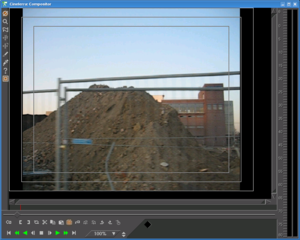 Sometimes in the past I had the wish to produce some simple videos, e. g. from political actions. Though I was looking for some free software solutions for video editing.
Sometimes in the past I had the wish to produce some simple videos, e. g. from political actions. Though I was looking for some free software solutions for video editing.I asked around but it seemed that most people didn't use free solutions. I never did any video editing before, so I had no comparison on what proprietary tools are able to do. My requirements where not that advanced, basically I wanted to be able to cut some videos together, fade them in and out, add some text over them. Beside, I wanted to be able to display images for some seconds.
I knew of three free video editing tools for linux, Kino, PiTiVi and Cinelerra. Kino and PiTiVi are quite simple to use, they have an intuitive interface. But I soon came to the conclusion that they are far too limited in features. So Cinelerra is left.
Cinelerra is not a simple tool, it's interface is not intuitive. So this was keeping me away from using it for a long time. But the good news is, Cinelerra has all the features I wanted and can do much more. As I said above, I don't have any experience with commercial tools, but I think Cinelerra can do pretty much everything one will need when doing professional video editing.
To learn how to use Cinelerra, there are some great video tutorials at the_source. It's a (CC-by licensed) video show about free software and video stuff and they did four Cinelerra tutorials in their show. You should at least watch the first three and try the stuff out between the tutorials, but that will give you the basic knowledge to get started with Cinelerra.
So, the first Cinelerra-produced video by me should be available here within the next days.
Beside, I just bumped the Cinelerra package in Gentoo, so emerge it and have fun.
Posted by Hanno Böck
in Computer culture, Gentoo, Linux, Movies
at
15:15
| Comments (2)
| Trackbacks (0)
Sunday, May 25. 2008
OpenStreetMap at the Open Source Expo in Karlsruhe
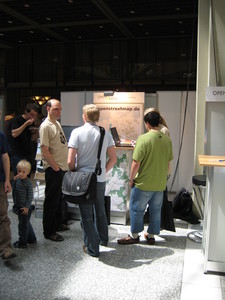 Today and tomorrow, we're presenting the OpenStreetMap-project at the Open Source Expo (or OpenExpo) in Karlsruhe.
Today and tomorrow, we're presenting the OpenStreetMap-project at the Open Source Expo (or OpenExpo) in Karlsruhe.I made some pictures, more will follow. Sadly, we didn't get a talk slot for OpenStreetMap.
Posted by Hanno Böck
in Computer culture, Copyright, English, Life, Linux
at
13:55
| Comments (0)
| Trackbacks (0)
Friday, May 16. 2008
Tic Tac Toe over Jabber
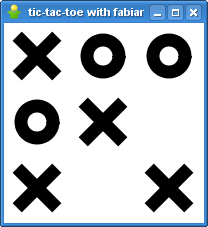 One of the missing features in jabber most commercial instant messaging systems have are small games one can easily play over them. Till now, because just yesterday, gajim got support for Tic Tac Toe over jabber.
One of the missing features in jabber most commercial instant messaging systems have are small games one can easily play over them. Till now, because just yesterday, gajim got support for Tic Tac Toe over jabber.Which reminds me tic tac toe was one of the first »programming projects« I did in the past, some day I'll have to dig out the sources and publish them. My next wish would be something like tetrinet over jabber.
Gajim-svn ebuild is in my overlay at http://svn.hboeck.de/overlay/.
Posted by Hanno Böck
in English, Gentoo, Linux, Retro Games
at
00:45
| Comments (2)
| Trackbacks (0)
Wednesday, April 23. 2008
Free software for your canon camera (CHDK)
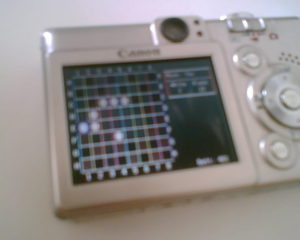 I own this Canon IXUS 50 camera for more than two years now. It's a fine device, but it has some small lacking features where I often asked myself if this could be enhanced with a new firmware.
I own this Canon IXUS 50 camera for more than two years now. It's a fine device, but it has some small lacking features where I often asked myself if this could be enhanced with a new firmware.Until recently, when I read about the CHDK project: It's a kind of firmware enhancements for Canon cameras. It doesn't fully replace the real firmware, but adds additional stuff (I must say I don't fully understand what they do). And now they have an experimental port for the SD400, which is built into my cam.
The first big killerfeature one will notice is that the cam now has a battery monitor, which is the most obvious lacking feature of the original firmware.
One more thing I always would've liked for my cam is a better video compression. The video quality is quite good, but the cam just can do mjpeg, which leads to big files and limits your maximum video size to about 20 minutes. It seems CHDK has some better compression video mode, but I'll have to dig deeper into it. Beside, I can now record raw images. So there's lot's of cool stuff to play with.
Monday, April 21. 2008
gajim with otr encryption
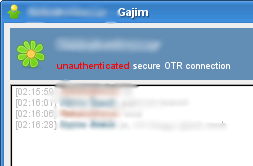 In the instant messaging world, encryption is a bit of a problem. There is no single standard that all clients share, mostly two methods of encryption are out there: pgp over jabber (as defined in the xmpp standard) and otr.
In the instant messaging world, encryption is a bit of a problem. There is no single standard that all clients share, mostly two methods of encryption are out there: pgp over jabber (as defined in the xmpp standard) and otr.Most clients only support either otr (pidgin, adium) or pgp (gajim, psi), for a long time I was looking for a solution where both methods work. psi has otr-patches, but they didn't work when I tried them. kopete also has an otr-plugin, but I've not tested that yet.
Today I found that there is an otr-branch of gajim, which is my everyday client, so this would be great. As you can see on the picture, it seems to work on a connection with an ICQ user using pidgin.
I've created some ebuilds in my overlay (the code is stored in bazaar, I've copied the bzr eclass from the desktop effects overlay):
svn co https://svn.hboeck.de/overlay
ping with IDN
 Today I asked myself if I can ping an IDN host.
Today I asked myself if I can ping an IDN host.My default ping (iputils on linux) couldn't do it, but I found some patches out there, e.g. from Fedora. Thanks to SpanKY, we now also have IDN-enabled ping in Gentoo (he used a modified patch).
Posted by Hanno Böck
in Computer culture, English, Gentoo, Linux
at
01:26
| Comments (2)
| Trackbacks (0)
Thursday, April 10. 2008
Wordpress mass hacks for pagerank
Today heise security brought a news that a growing number of old wordpress installations get's misused by spammers to improve their pagerank. I've more or less waited for something like that, because it's quite obvious: If you have an automated mechanism to use security holes in a popular web application, you can search for them with a search engine (google, the mighty hacktool) and usually it's quite trivial to detect both application and version.
This isn't a wordpress-thing only, this can happen to pretty much every widespread web application. Wordpress had a lot of security issues recently and is very widespread, so it's an obvious choice. But other incidents like this will follow and future ones probably will affect more different web applications.
The conclusion is quite simple: If you're installing a web application yourself, you are responsible for it! You need to look for security updates and you need to install them, else you might be responsible for spammers actions. And there's no »nobody is interested in my little blog«-excuse, as these are not attacks against an individual page, but mass attacks.
For administrators, I wrote a little tool a while back, where I had such incidents in mind: freewvs, it checks locally on the filesystem for web applications and knows about vulnerabilities, so it'll tell you which web applications need updates. It already detects a whole bunch of apps, while more is always better and if you'd like to help, I'd gladly accept patches for more applications (the format is quite simple).
With it, server administrators can check the webroots of thier users and nag them if they have outdated cruft laying around.
This isn't a wordpress-thing only, this can happen to pretty much every widespread web application. Wordpress had a lot of security issues recently and is very widespread, so it's an obvious choice. But other incidents like this will follow and future ones probably will affect more different web applications.
The conclusion is quite simple: If you're installing a web application yourself, you are responsible for it! You need to look for security updates and you need to install them, else you might be responsible for spammers actions. And there's no »nobody is interested in my little blog«-excuse, as these are not attacks against an individual page, but mass attacks.
For administrators, I wrote a little tool a while back, where I had such incidents in mind: freewvs, it checks locally on the filesystem for web applications and knows about vulnerabilities, so it'll tell you which web applications need updates. It already detects a whole bunch of apps, while more is always better and if you'd like to help, I'd gladly accept patches for more applications (the format is quite simple).
With it, server administrators can check the webroots of thier users and nag them if they have outdated cruft laying around.
Posted by Hanno Böck
in Computer culture, English, Linux, Security
at
02:44
| Comment (1)
| Trackbacks (0)
Monday, April 7. 2008
Augsburger Allgemeine schreibt über Linux-Infotag
Und erwähnt mich. Zitat:
Hanno Böck, der die freie Geodatenbank Openstreetmap vorstellte, war extra nach Augsburg gereist, da es »hier noch besonders viel zu tun gibt«. Ein Blick auf eine Augsburger Stadtkarte zeigte, was er meint: Einige Straßen sind schon drin, Bahnlinie und Hauptbahnhof auch, sogar Sträßchen wie Kappelberg, Milchberg, Bäckergasse und Hallstraße sind eingezeichnet. Aber wo ist die Maximilianstraße? Der Rathausplatz? Da sieht es doch recht leer aus.
Augsburger Allgemeine: Damit der PC mit seinem Nutzer rechnen kann
Hanno Böck, der die freie Geodatenbank Openstreetmap vorstellte, war extra nach Augsburg gereist, da es »hier noch besonders viel zu tun gibt«. Ein Blick auf eine Augsburger Stadtkarte zeigte, was er meint: Einige Straßen sind schon drin, Bahnlinie und Hauptbahnhof auch, sogar Sträßchen wie Kappelberg, Milchberg, Bäckergasse und Hallstraße sind eingezeichnet. Aber wo ist die Maximilianstraße? Der Rathausplatz? Da sieht es doch recht leer aus.
Augsburger Allgemeine: Damit der PC mit seinem Nutzer rechnen kann
Sunday, March 30. 2008
Linux-Infotag Augsburg
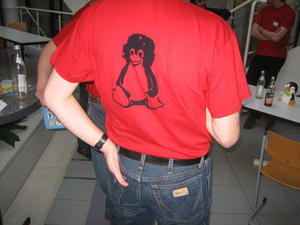 Gestern war ich auf dem Augsburger Linux-Infotag. Ein kleines, aber feines Linux-Event für den im Moment etwas unterrepräsentierten süddeutschen Raum.
Gestern war ich auf dem Augsburger Linux-Infotag. Ein kleines, aber feines Linux-Event für den im Moment etwas unterrepräsentierten süddeutschen Raum.Mein OpenStreetMap-Vortrag wurde von knapp 50 Menschen besucht und lief ganz passabel. Erste Spuren in der bislang etwas vernachlässigten Augsburger Innenstadt sind schon sichtbar (Slides wie üblich hier, aber kaum verändert zum letzten Mal).
Am CAcert-Stand war man optimistisch, dass noch (Zitat) »dieses Frühjahr« die Firefox-Integration klappt (aber das habe ich schon oft gehört...), die Freifunker in Augsburg sind nett, PacketRadio und Amateurfunk taugt nicht für Freifunk (due to Gesetz, welches den Content einschränkt) und insgesamt war es ein nettes Event. Ich denke nächstes Mal bin ich wieder dabei.
Bilder vom Linux-Infotag Augsburg gibt's hier.
Wednesday, March 12. 2008
A try on current nouveau
nouveau, the project for creating a free 3D linux driver for nvidia cards, recently got first support for real 3D applications with gallium on some NV4X cards (see Nouveau Companion 36). Today I got it working on a friends machine.
Here you can see an openarena benchmark (also uploaded on youtube). It got 55 fps, which is far away from the nvidia binary driver yet (178 fps), but at least more than my r200 setup (32 fps).
For the brave ones, here's a quick and dirty howto for Gentoo:
a) Get the nouveau overlay with svn co https://svn.hboeck.de/nouveau-overlay and add it to PORTDIR_OVERLAY in make.conf.
b) The nouveau-overlay won't install the nouveau/gallium-branch of mesa. Get my overlay with svn co https://svn.hboeck.de/overlay and also add that to your PORTDIR_OVERLAY (I'll try to contact the nouveau-overlay developer if we can merge this).
b) Add media-libs/mesa, x11-base/x11-drm, x11-libs/libdrm and x11-drivers/xf86-video-nouveau to /etc/portage/package.keywords and merge them.
c) If you've been running the nvidia binary driver, eselect opengl set xorg-x11, change the graphics driver in xorg.conf to nouveau, rmmod nvidia (if you've been running the binary driver), modprobe nouveau and start X.
d) Have fun!
Note: The nouveau developers consider gallium completely unsupported at the moment and don't want to get end-user bugs. If it runs, fine, if not, don't nag them with it.
Here you can see an openarena benchmark (also uploaded on youtube). It got 55 fps, which is far away from the nvidia binary driver yet (178 fps), but at least more than my r200 setup (32 fps).
For the brave ones, here's a quick and dirty howto for Gentoo:
a) Get the nouveau overlay with svn co https://svn.hboeck.de/nouveau-overlay and add it to PORTDIR_OVERLAY in make.conf.
b) The nouveau-overlay won't install the nouveau/gallium-branch of mesa. Get my overlay with svn co https://svn.hboeck.de/overlay and also add that to your PORTDIR_OVERLAY (I'll try to contact the nouveau-overlay developer if we can merge this).
b) Add media-libs/mesa, x11-base/x11-drm, x11-libs/libdrm and x11-drivers/xf86-video-nouveau to /etc/portage/package.keywords and merge them.
c) If you've been running the nvidia binary driver, eselect opengl set xorg-x11, change the graphics driver in xorg.conf to nouveau, rmmod nvidia (if you've been running the binary driver), modprobe nouveau and start X.
d) Have fun!
Note: The nouveau developers consider gallium completely unsupported at the moment and don't want to get end-user bugs. If it runs, fine, if not, don't nag them with it.
Posted by Hanno Böck
in Computer culture, Copyright, English, Gentoo, Linux
at
00:06
| Comments (3)
| Trackbacks (0)
« previous page
(Page 5 of 16, totaling 238 entries)
» next page
